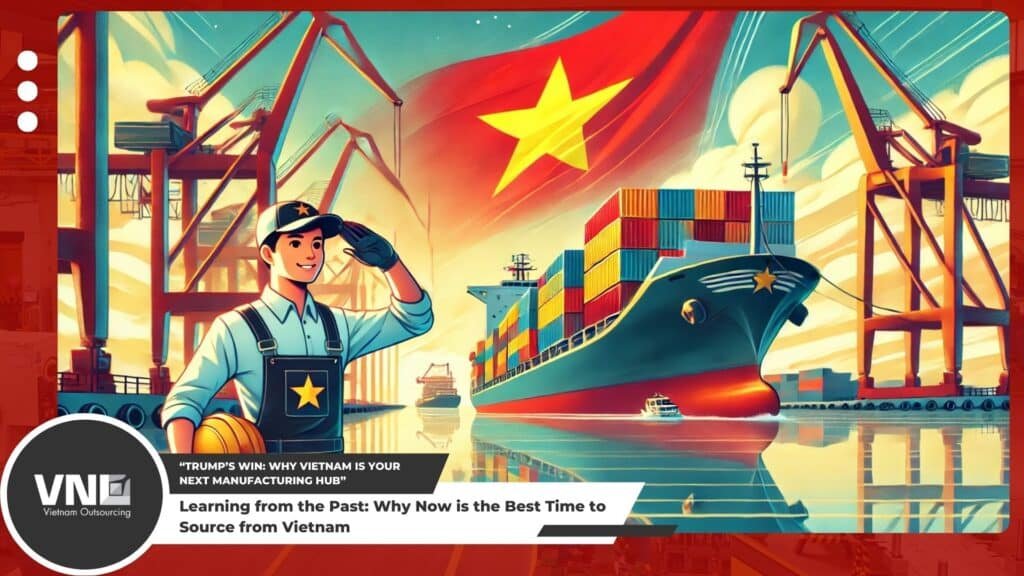Introduction
Global trade has faced significant disruptions over the past decade, from the U.S.-China trade war to the COVID-19 pandemic and ongoing geopolitical tensions. These events have forced businesses to reevaluate their supply chains, emphasizing the need for stability, diversification, and cost efficiency.
Vietnam has emerged as a standout outsourcing destination, offering a combination of resilience, adaptability, and competitive advantages. This article reflects on the lessons learned from earlier trade disruptions and explains why now is the ideal time for Western businesses to source from Vietnam factories.
1. Lessons from Past Trade Disruptions
The U.S.-China Trade War
The trade war between the U.S. and China highlighted the risks of over-reliance on a single supplier:
- Tariff Impacts: In 2018, the U.S. imposed tariffs of up to 25% on Chinese goods, significantly raising costs for Western businesses reliant on Chinese manufacturing.
- Supply Chain Shifts: Many companies began diversifying their production lines to countries like Vietnam to avoid increased costs and maintain competitive pricing.
Vietnam benefited from this shift, with exports to the U.S. rising by 25% in 2019 alone (U.S. Census Bureau). Today, Vietnam remains a preferred alternative due to its cost advantages and strong trade relations with Western markets.
COVID-19 Pandemic
The pandemic further exposed vulnerabilities in global supply chains:
- Disruptions in China: Strict lockdowns and factory closures in China created significant delays for businesses dependent on Chinese manufacturing.
- Vietnam’s Stability: Despite early pandemic challenges, Vietnam managed to resume production quickly, ensuring continuity for industries like metal manufacturing and precision machinery.
Ongoing Geopolitical Tensions
Ongoing geopolitical dynamics, including U.S.-China tensions and regional disputes, continue to push companies toward diversifying their sourcing strategies. Vietnam’s neutral geopolitical stance makes it an attractive and stable partner.
2. Why Vietnam Stands Out Today
Cost Efficiency
Vietnam offers significant cost advantages compared to other manufacturing hubs:
- Labor Costs: Average monthly wages in Vietnam are $320, compared to $850 in China and $4,000 in the U.S. (Statista, 2024).
- Operational Costs: Industrial lease rates range between $100 and $180 per square meter annually, far lower than China’s $300–$350 per square meter.
These savings are particularly beneficial for industries requiring labor-intensive processes like sheet metal forming, die casting, or aluminum product manufacturing.
Trade Agreements
Vietnam’s participation in multiple trade agreements enhances its appeal as a sourcing destination:
- EU-Vietnam Free Trade Agreement (EVFTA): Reduces tariffs on exports like metal components to 0%, providing cost savings for European buyers.
- Comprehensive and Progressive Agreement for Trans-Pacific Partnership (CPTPP): Strengthens trade access to major markets like Canada, Japan, and Australia.
Skilled Workforce
Vietnam’s workforce is young, skilled, and increasingly experienced:
- Over 60% of the population is under 35, with a large proportion trained in technical fields.
- Factories producing precision machinery, copper components, and valves benefit from a growing pool of qualified workers.
3. Vietnam’s Resilience in the Face of Disruptions
Rapid Recovery Capabilities
Vietnam has consistently demonstrated its ability to recover quickly from global disruptions:
- During the pandemic, Vietnam reopened factories ahead of many competitors, maintaining a steady supply of goods like railguard safety systems and roof jacks.
- Its government’s proactive policies, including financial support for industries and workers, ensured minimal downtime.
Geopolitical Stability
Vietnam’s neutral stance in global politics has enabled it to avoid trade conflicts while strengthening relationships with key markets like the U.S. and EU:
- In 2023, Vietnam’s exports to the U.S. reached $110 billion, up 11.5% year-on-year (U.S. Census Bureau).
- This stability positions Vietnam as a reliable sourcing destination for Western businesses seeking to mitigate risks.
4. Strategic Advantages for Western Businesses
Diversification Opportunities
Sourcing from Vietnam reduces dependence on a single country like China, ensuring more resilient supply chains. Western businesses sourcing hydraulic press machine frames, main chutes, or other critical products benefit from Vietnam’s ability to scale production while maintaining quality.
Commitment to Quality
Vietnamese manufacturers prioritize adherence to international standards:
- Over 85% of Vietnam factories are ISO 9001 certified for quality management.
- Technological advancements, including IoT and robotics, ensure consistent production of precision machinery and aluminum products.
5. The Future of Vietnam in Global Manufacturing
Vietnam is poised to strengthen its role as a global manufacturing powerhouse:
- Infrastructure Investments: The government is investing over $15 billion annually in expanding ports, highways, and industrial parks to support its growing manufacturing base.
- High-Tech Focus: Factories are integrating advanced technologies like CNC machining and AI to cater to high-precision industries, including automotive and aerospace.
With a projected compound annual growth rate (CAGR) of 8.3% for Vietnam manufacturing sector from 2024 to 2030 (McKinsey, 2024), Vietnam is well-positioned to meet the demands of Western markets.
Conclusion
The lessons of the past decade have underscored the importance of resilient and diversified supply chains. Vietnam has consistently demonstrated its ability to adapt to global challenges, offering Western businesses a stable and promising outsourcing destination.
For companies seeking reliable partners for metal manufacturing, sheet metal forming, or precision machinery, Vietnam’s factories offer a combination of cost efficiency, quality, and geopolitical stability. With the right strategies and partnerships, there has never been a better time to source from Vietnam. More insight can be found at Compliance & Supply Chain in Vietnam.









